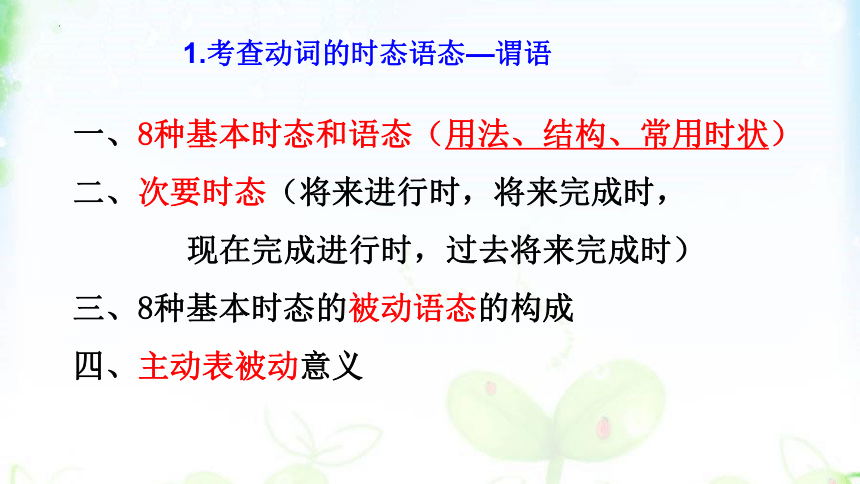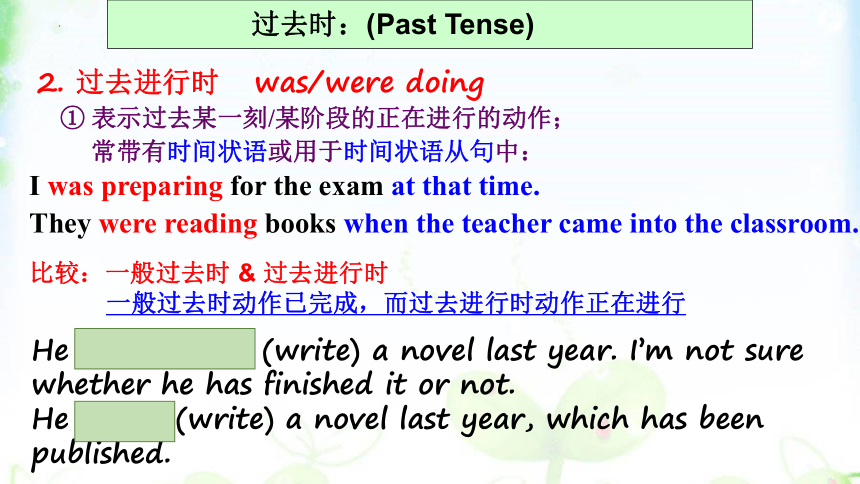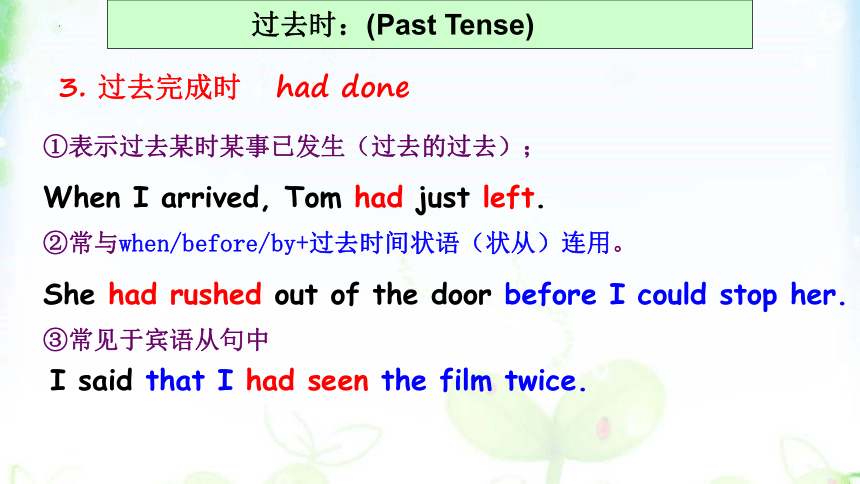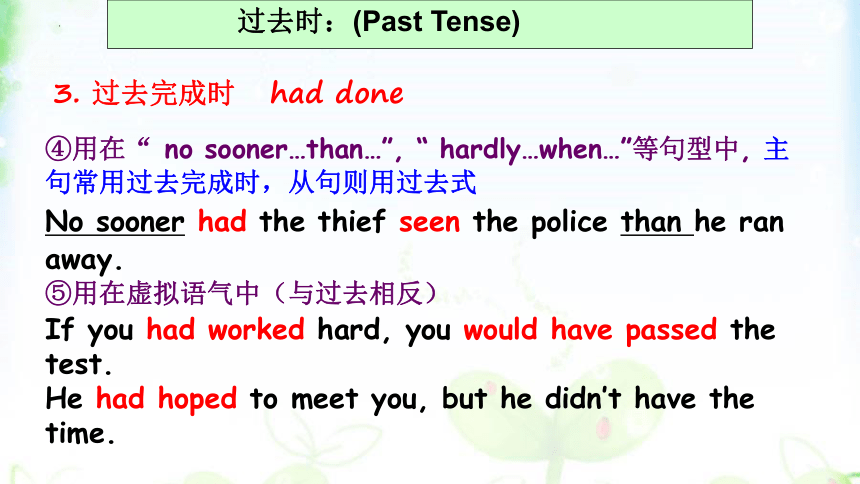2023届高三英语二轮复习:词类 动词的时态语态(谓语) 课件(共28张PPT)
文档属性
| 名称 | 2023届高三英语二轮复习:词类 动词的时态语态(谓语) 课件(共28张PPT) |  | |
| 格式 | pptx | ||
| 文件大小 | 205.5KB | ||
| 资源类型 | 教案 | ||
| 版本资源 | 通用版 | ||
| 科目 | 英语 | ||
| 更新时间 | 2022-10-10 11:57:09 | ||
图片预览









文档简介
(共28张PPT)
高考总复习—英语
语法专项复习
一、词类 动词的时态语态(谓语)
动
词
谓语动词
非谓语动词
连系动词
am is are was were
look sound seem get turn
实意动词/行为动词(vt./vi)
run sing learn say write
助动词
do does did have has will
情态动词
can may must need dare
不定式 ( to do )
现在分词 ( V-ing )
过去分词 ( V-ed )
什么是谓语动词?什么是非谓语动词?
The man coming from America is my teacher.
He will attend the meeting to be held next week.
It being fine, we decide to go for a picnic.
She has us laughing all through the meal.
Having finished his work, he went home.
Reminded not to be late, Jim hurried to school.
高考英语对动词的考查比较广泛,但归纳起来有以下几个特点:
考查动词的时态语态(谓语)
考查动词的非谓语形式
考点梳理 精讲
考查动词的时态语态—谓语
一、8种基本时态和语态(用法、结构、常用时状)
二、次要时态(将来进行时,将来完成时,
现在完成进行时,过去将来完成时)
三、8种基本时态的被动语态的构成
四、主动表被动意义
一、主要时态
1)过去发生的动作或状态。
2)过去某个时间经常发生的事情
3)特定的句型中
过去时:(Past Tense)
常与一般过去时搭配的时间状语:a few days ago, yesterday, last Sunday, in 1990, the other day, at that time, just now, in the past 等
1. 一般过去时 did / was were
I met her in the street yesterday.
He was very busy last night.
We often went boating when we were children.
① 表示过去某一刻/某阶段的正在进行的动作;
常带有时间状语或用于时间状语从句中:
过去时:(Past Tense)
比较:一般过去时 & 过去进行时
一般过去时动作已完成,而过去进行时动作正在进行
2. 过去进行时 was/were doing
He was writing (write) a novel last year. I’m not sure whether he has finished it or not.
He wrote (write) a novel last year, which has been published.
I was preparing for the exam at that time.
They were reading books when the teacher came into the classroom.
①表示过去某时某事已发生(过去的过去);
When I arrived, Tom had just left.
②常与when/before/by+过去时间状语(状从)连用。
She had rushed out of the door before I could stop her.
③常见于宾语从句中
过去时:(Past Tense)
3. 过去完成时 had done
I said that I had seen the film twice.
④用在“ no sooner…than…”, “ hardly…when…”等句型中, 主句常用过去完成时,从句则用过去式
No sooner had the thief seen the police than he ran away.
⑤用在虚拟语气中(与过去相反)
If you had worked hard, you would have passed the test.
He had hoped to meet you, but he didn’t have the time.
过去时:(Past Tense)
3. 过去完成时 had done
常与一般现在时搭配的时间adv.和时间状语: often (usually, regularly, frequently), sometimes (once in a while, now and then, at times, occasionally), seldom, rarely, hardly, never 等。
现在时:(Present Tense)
1、一般现在时:do/does am/are/is
现在时:(Present Tense)
①表示现在发生的动作、情况、状态和特征。
Smith owns a car and a house.
② 经常性、习惯性或反复发生的动作。
He always helps others.
③客观事实和普遍真理。 (不受时态限制)
The geography teacher told us the earth moves around the sun.
1、一般现在时:do/does am/are/is
1. 在时间、条件或让步状语从句中,一般现在时代替将来时
When he arrives, we will go out to meet him.
2. 表示现在已安排好的未来事项,行程等活动, 如: 飞机、火车、轮船、等定期定点运行的交通方式也用一般现在时代替将来时
The museum opens at ten tomorrow.
The train starts at six this afternoon.
一般现在时代替将来时情况
①表示正在进行的动作和发生的事;
It is raining now.
② 现阶段正发生的事(此刻动作不一定正在进行)。
Tom, are you still working in that bank
③ 表说话人的情绪(句子中有频率副词)
She is constantly changing her mind.
④ 事物逐渐发展过程
It’s getting colder and colder.
现在时:(Present Tense)
常与现在进行时搭配的时状: now, at this moment, at this time等。
2. 现在进行时 am/is/are doing
⑤表示位置移动意义的动词come, go, arrive, leave, start 等与进行时 连用表将来含义
The final exam is drawing near/coming/approaching.
I am leaving.
2. 现在进行时 am/is/are doing
现在进行时表将来时情况
3. 现在完成时 have/has done
①事情已发生,但与现在情况还有联系;
They have gone to town.
② 常与just、already、yet、recently/lately、for/since、so far, up to now, in recent years, over/in the past/last few years, ever, before等连用。
The rain has already stopped.
现在时:(Present Tense)
比较:一般过去时- 过去发生的事情,与现在没有联系。
凡有过去时间状语时,只能用过去时。
They gave it to me just now.
现在时:(Present Tense)
③ 用在一些固定结构中
It is the first time that I have visited the city.
This was the third time that I had visited the city.
这是某人第一次做……
3. 现在完成时 have/has done
注意:只有延续性动词才能与延续性时间状语连用
He has joined the army for three years.
He has been in the army for three years.
He joined the army three years ago.
×
√
√
4. 现在完成进行时 have/has been doing
①由过去某一时间开始一直延续到现在的动作,这动作有可能刚结束,也可能要进行下去。
What have you been doing all these years
He has been living here since 2001.
现在时:(Present Tense)
I have made a cake.
I have been making a cake.
比较:现在完成时:
现在完成时动作已完成,而现在完成进行时却不一定。
1. 一般将来时 will/shall do
将来时:(Future Tense)
常与一般将来时搭配的时间状语:tomorrow, next week, in a few days等
① will/shall do 其中shall用于第一人称
We shall meet this morning.
② be going to 打算,可能 (根据现象推测)
There is going to be a wonderful film tonight.
Look at the clouds. There is going to be a storm.
③ be about to do 马上(不与具体时间状语连用)
The train is about to start.
④ be to 按计划,正式安排将发生
Are you to meet at the entrance to the park
将来时:(Future Tense)
2. 过去将来时 would do
①表示用过去观点看将要发生的事(常用于宾从中)。
I thought the roses would come out soon.
二、次要时态
将来进行时,表示将来的某个时候正在进行的动作(will be doing)
At this time tomorrow, we will be driving across the big desert ahead.
2. 将来完成时,表示将来的某个时候某一动作已经完成( will have done )
By this time tomorrow, we will have finished our task.
3. 现在完成进行时表示一直在做某事并且该动作还在继续(have/has been doing)
The foreign scientist has been working in our college for 9 years and does not want to leave.
4. 过去将来完成时用于虚拟语气中(would have done)
I would have succeeded if I had worked hard enough.
三、被动语态的构成
1 现在进行时
2 一般现在时
3 现在完成时
4 一般将来时
5 过去进行时
6 一般过去式
7 过去将来时
8 过去完成时
am/is /are being done
am/is /are done
have/has been done
will be done
was/were being done
was/were done
would be done
had been done
系动词 look, sound, taste, feel, smell; become, turn, get, go; keep, stay, remain; seem, appear, prove, turn out 等不用被动语态
How sweet the flowers smell in the garden.
He proves (to be) right.
2. move, lock, shut, open 等动词与can’t 或 won’t 连用时。
The door won’t lock.
3. read, write, wash, clean, draw, burn, cook, wear
等与well, easily 等副词连用时
The door washes easily.
The new product sells well./The raincoat wears well.
四、主动表被动意义
4. be worth doing
5. sth need/require/want doing 句型
The book is worth reading.
=It’s worthwhile to read the book.
=It’s worthwhile reading the book.
= The book is worthy to be read.
=The book is worthy of being read.
My bike needs repairing.
=My bike needs to be repaired.
6. 句型:主语 + be + adj. + to do
该句型中,主语与动词不定式(作程度状语)之间是动宾关系,但是要求用动词不定式的主动形式表示被动含义。常用于该句型的形容词有easy, hard, difficult, heavy, fit, interesting, pleasant, comfortable等。
The text is difficult to understand.
Polluted water is unfit to drink.
Your new jacket is nice to look at.
另: 主语 + be + adj. + enough + to do
主语 + be + too + adj. + to do
There was nothing to deal with, so I went home.
With a lot to do, I felt uneasy.
She had only a small room to live in.
8. 不用被动语态的动词 happen, take place, come about,break out, belong to, rise, add up to等
His whole schooling added up to no more than six months.
Great changes have taken place in my hometown.
表示“有”的 there be, with, have 后面的动词
注意以下动词或动词短语用主动语态与被动语态的情况
1 The book came out/was published last year. (出版)
2. I gave out /was worn out after the long walk. (精疲力竭)
3. Class ended/was dismissed at 12. (结束)
4. Our class consists of /is made up of /is composed of 50 students. (由…组成)
5. The meeting will take place/will be held in a fortnight. (举行)
6. The car broke down/got broken on the way home. (坏了)
7. I have run out of /used up my ink. (用尽)
=My ink has run out/has been used up.
8. The house belongs to me/is owned by me. (属于)
9. His hard work paid off/was rewarded. (得到回报,值得)
解题技巧:
判断句子是否需要谓语?
找出该谓语动词的主语,判断语态?
找出句子时状、结构或上下文确定时态?
根据时态结构进行变形,检查动词变形是否正确?
检查主谓一致?
判断不需动词,那是否需名词、形容词、副词?
检查句意
下一节课
高考总复习—英语
语法专项复习
一、词类 动词的时态语态(谓语)
动
词
谓语动词
非谓语动词
连系动词
am is are was were
look sound seem get turn
实意动词/行为动词(vt./vi)
run sing learn say write
助动词
do does did have has will
情态动词
can may must need dare
不定式 ( to do )
现在分词 ( V-ing )
过去分词 ( V-ed )
什么是谓语动词?什么是非谓语动词?
The man coming from America is my teacher.
He will attend the meeting to be held next week.
It being fine, we decide to go for a picnic.
She has us laughing all through the meal.
Having finished his work, he went home.
Reminded not to be late, Jim hurried to school.
高考英语对动词的考查比较广泛,但归纳起来有以下几个特点:
考查动词的时态语态(谓语)
考查动词的非谓语形式
考点梳理 精讲
考查动词的时态语态—谓语
一、8种基本时态和语态(用法、结构、常用时状)
二、次要时态(将来进行时,将来完成时,
现在完成进行时,过去将来完成时)
三、8种基本时态的被动语态的构成
四、主动表被动意义
一、主要时态
1)过去发生的动作或状态。
2)过去某个时间经常发生的事情
3)特定的句型中
过去时:(Past Tense)
常与一般过去时搭配的时间状语:a few days ago, yesterday, last Sunday, in 1990, the other day, at that time, just now, in the past 等
1. 一般过去时 did / was were
I met her in the street yesterday.
He was very busy last night.
We often went boating when we were children.
① 表示过去某一刻/某阶段的正在进行的动作;
常带有时间状语或用于时间状语从句中:
过去时:(Past Tense)
比较:一般过去时 & 过去进行时
一般过去时动作已完成,而过去进行时动作正在进行
2. 过去进行时 was/were doing
He was writing (write) a novel last year. I’m not sure whether he has finished it or not.
He wrote (write) a novel last year, which has been published.
I was preparing for the exam at that time.
They were reading books when the teacher came into the classroom.
①表示过去某时某事已发生(过去的过去);
When I arrived, Tom had just left.
②常与when/before/by+过去时间状语(状从)连用。
She had rushed out of the door before I could stop her.
③常见于宾语从句中
过去时:(Past Tense)
3. 过去完成时 had done
I said that I had seen the film twice.
④用在“ no sooner…than…”, “ hardly…when…”等句型中, 主句常用过去完成时,从句则用过去式
No sooner had the thief seen the police than he ran away.
⑤用在虚拟语气中(与过去相反)
If you had worked hard, you would have passed the test.
He had hoped to meet you, but he didn’t have the time.
过去时:(Past Tense)
3. 过去完成时 had done
常与一般现在时搭配的时间adv.和时间状语: often (usually, regularly, frequently), sometimes (once in a while, now and then, at times, occasionally), seldom, rarely, hardly, never 等。
现在时:(Present Tense)
1、一般现在时:do/does am/are/is
现在时:(Present Tense)
①表示现在发生的动作、情况、状态和特征。
Smith owns a car and a house.
② 经常性、习惯性或反复发生的动作。
He always helps others.
③客观事实和普遍真理。 (不受时态限制)
The geography teacher told us the earth moves around the sun.
1、一般现在时:do/does am/are/is
1. 在时间、条件或让步状语从句中,一般现在时代替将来时
When he arrives, we will go out to meet him.
2. 表示现在已安排好的未来事项,行程等活动, 如: 飞机、火车、轮船、等定期定点运行的交通方式也用一般现在时代替将来时
The museum opens at ten tomorrow.
The train starts at six this afternoon.
一般现在时代替将来时情况
①表示正在进行的动作和发生的事;
It is raining now.
② 现阶段正发生的事(此刻动作不一定正在进行)。
Tom, are you still working in that bank
③ 表说话人的情绪(句子中有频率副词)
She is constantly changing her mind.
④ 事物逐渐发展过程
It’s getting colder and colder.
现在时:(Present Tense)
常与现在进行时搭配的时状: now, at this moment, at this time等。
2. 现在进行时 am/is/are doing
⑤表示位置移动意义的动词come, go, arrive, leave, start 等与进行时 连用表将来含义
The final exam is drawing near/coming/approaching.
I am leaving.
2. 现在进行时 am/is/are doing
现在进行时表将来时情况
3. 现在完成时 have/has done
①事情已发生,但与现在情况还有联系;
They have gone to town.
② 常与just、already、yet、recently/lately、for/since、so far, up to now, in recent years, over/in the past/last few years, ever, before等连用。
The rain has already stopped.
现在时:(Present Tense)
比较:一般过去时- 过去发生的事情,与现在没有联系。
凡有过去时间状语时,只能用过去时。
They gave it to me just now.
现在时:(Present Tense)
③ 用在一些固定结构中
It is the first time that I have visited the city.
This was the third time that I had visited the city.
这是某人第一次做……
3. 现在完成时 have/has done
注意:只有延续性动词才能与延续性时间状语连用
He has joined the army for three years.
He has been in the army for three years.
He joined the army three years ago.
×
√
√
4. 现在完成进行时 have/has been doing
①由过去某一时间开始一直延续到现在的动作,这动作有可能刚结束,也可能要进行下去。
What have you been doing all these years
He has been living here since 2001.
现在时:(Present Tense)
I have made a cake.
I have been making a cake.
比较:现在完成时:
现在完成时动作已完成,而现在完成进行时却不一定。
1. 一般将来时 will/shall do
将来时:(Future Tense)
常与一般将来时搭配的时间状语:tomorrow, next week, in a few days等
① will/shall do 其中shall用于第一人称
We shall meet this morning.
② be going to 打算,可能 (根据现象推测)
There is going to be a wonderful film tonight.
Look at the clouds. There is going to be a storm.
③ be about to do 马上(不与具体时间状语连用)
The train is about to start.
④ be to 按计划,正式安排将发生
Are you to meet at the entrance to the park
将来时:(Future Tense)
2. 过去将来时 would do
①表示用过去观点看将要发生的事(常用于宾从中)。
I thought the roses would come out soon.
二、次要时态
将来进行时,表示将来的某个时候正在进行的动作(will be doing)
At this time tomorrow, we will be driving across the big desert ahead.
2. 将来完成时,表示将来的某个时候某一动作已经完成( will have done )
By this time tomorrow, we will have finished our task.
3. 现在完成进行时表示一直在做某事并且该动作还在继续(have/has been doing)
The foreign scientist has been working in our college for 9 years and does not want to leave.
4. 过去将来完成时用于虚拟语气中(would have done)
I would have succeeded if I had worked hard enough.
三、被动语态的构成
1 现在进行时
2 一般现在时
3 现在完成时
4 一般将来时
5 过去进行时
6 一般过去式
7 过去将来时
8 过去完成时
am/is /are being done
am/is /are done
have/has been done
will be done
was/were being done
was/were done
would be done
had been done
系动词 look, sound, taste, feel, smell; become, turn, get, go; keep, stay, remain; seem, appear, prove, turn out 等不用被动语态
How sweet the flowers smell in the garden.
He proves (to be) right.
2. move, lock, shut, open 等动词与can’t 或 won’t 连用时。
The door won’t lock.
3. read, write, wash, clean, draw, burn, cook, wear
等与well, easily 等副词连用时
The door washes easily.
The new product sells well./The raincoat wears well.
四、主动表被动意义
4. be worth doing
5. sth need/require/want doing 句型
The book is worth reading.
=It’s worthwhile to read the book.
=It’s worthwhile reading the book.
= The book is worthy to be read.
=The book is worthy of being read.
My bike needs repairing.
=My bike needs to be repaired.
6. 句型:主语 + be + adj. + to do
该句型中,主语与动词不定式(作程度状语)之间是动宾关系,但是要求用动词不定式的主动形式表示被动含义。常用于该句型的形容词有easy, hard, difficult, heavy, fit, interesting, pleasant, comfortable等。
The text is difficult to understand.
Polluted water is unfit to drink.
Your new jacket is nice to look at.
另: 主语 + be + adj. + enough + to do
主语 + be + too + adj. + to do
There was nothing to deal with, so I went home.
With a lot to do, I felt uneasy.
She had only a small room to live in.
8. 不用被动语态的动词 happen, take place, come about,break out, belong to, rise, add up to等
His whole schooling added up to no more than six months.
Great changes have taken place in my hometown.
表示“有”的 there be, with, have 后面的动词
注意以下动词或动词短语用主动语态与被动语态的情况
1 The book came out/was published last year. (出版)
2. I gave out /was worn out after the long walk. (精疲力竭)
3. Class ended/was dismissed at 12. (结束)
4. Our class consists of /is made up of /is composed of 50 students. (由…组成)
5. The meeting will take place/will be held in a fortnight. (举行)
6. The car broke down/got broken on the way home. (坏了)
7. I have run out of /used up my ink. (用尽)
=My ink has run out/has been used up.
8. The house belongs to me/is owned by me. (属于)
9. His hard work paid off/was rewarded. (得到回报,值得)
解题技巧:
判断句子是否需要谓语?
找出该谓语动词的主语,判断语态?
找出句子时状、结构或上下文确定时态?
根据时态结构进行变形,检查动词变形是否正确?
检查主谓一致?
判断不需动词,那是否需名词、形容词、副词?
检查句意
下一节课
